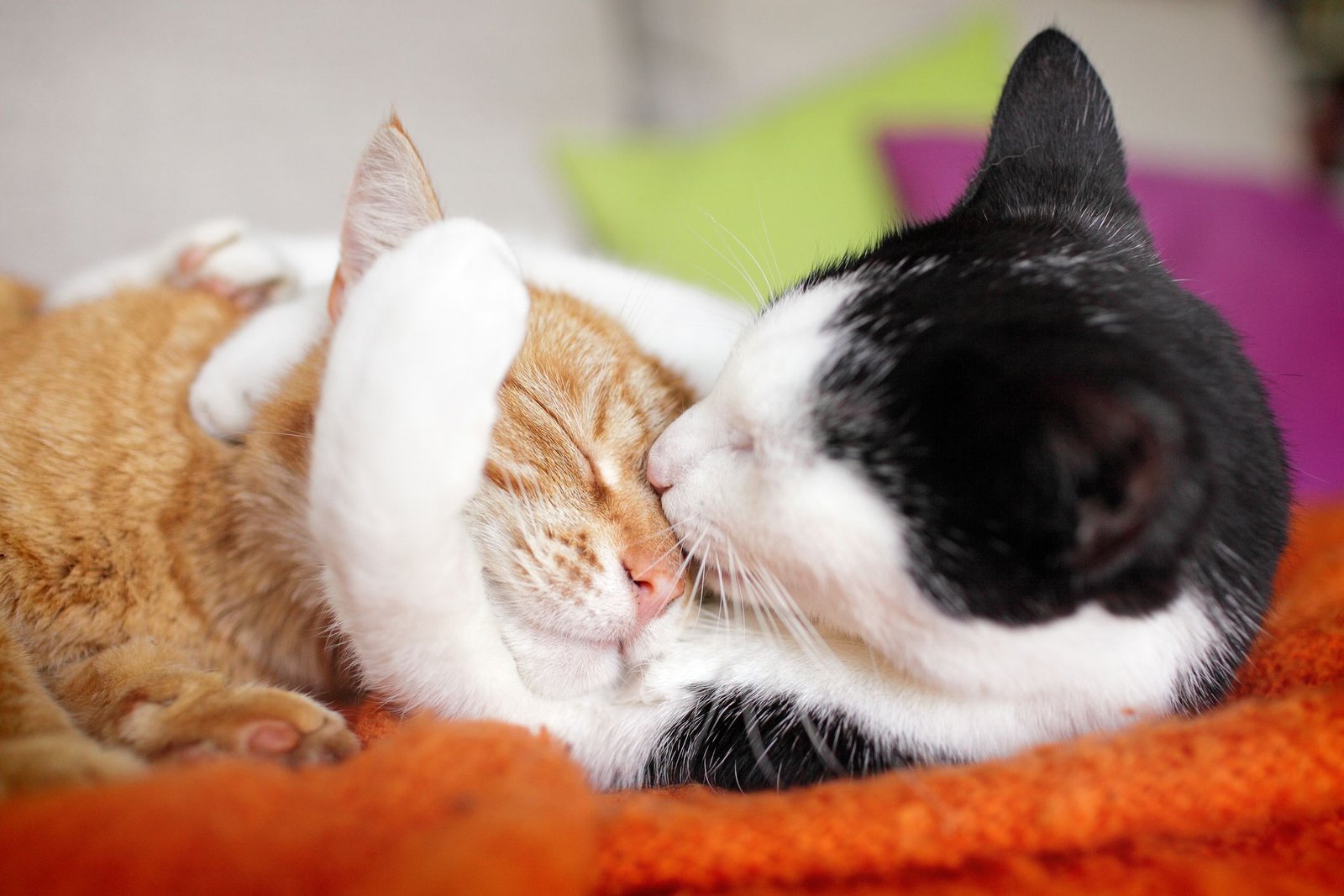Cat mating and reproduction can occur after just one successful mating during the female cat’s fertile period, which usually lasts for about a week and happens multiple times during the breeding season. This is an amazing and complex process that can continue for many years unless the cats are spayed or neutered.
Proper planning and research are important for cat breeding, including ensuring the health of the female cat and preparing for the breeding process. In this guide, we will explore the steps and behaviors of cat mating, as well as provide insights into the reproduction of cats.

Credit: www.petmiconnect.com
Introduction To Cat Mating And Reproduction
Discover the intricacies of cat mating and reproduction in this comprehensive guide. From understanding their fertile period to the steps of mating behavior, this resource provides valuable insights into this fascinating process.
Cat mating and reproduction is a fascinating and complex process. Understanding the behaviors and cycles involved can help cat owners make informed decisions about breeding, spaying, and neutering. In this guide, we will explore the key aspects of cat mating and reproduction, including the understanding of cat mating behavior, the estrus cycle in cats, and the importance of spaying and neutering.
Understanding Cat Mating Behavior
Cat mating behavior is unique and can vary between individuals. It is important to understand how cats communicate and interact during the mating process to ensure a successful breeding. Male cats, or toms, will often display behaviors such as spraying urine to mark their territory and vocalizing loudly to attract females. Female cats, or queens, may exhibit behaviors like rolling around on the ground, raising their hindquarters, and vocalizing to signal their readiness to mate. By observing these behaviors, cat owners can determine the best time for breeding.
The Estrus Cycle In Cats
The estrus cycle, also known as heat, is an important reproductive cycle in female cats. It is the period when the female is fertile and capable of conceiving. The estrus cycle typically lasts for about a week, but it can vary between individual cats. During this time, the female releases pheromones and may exhibit more affectionate behaviors towards males. It is crucial to be aware of the signs of estrus in order to prevent unwanted or unplanned pregnancies.
Importance Of Spaying And Neutering
Spaying and neutering are essential procedures for controlling the cat population and preventing certain health issues. Spaying refers to the surgical removal of the female cat’s uterus and ovaries, while neutering involves the removal of the testicles in male cats. By spaying or neutering your cat, you can prevent unwanted litters, reduce the risk of certain cancers, prevent certain behavioral issues, and contribute to the overall welfare of your pet. It is recommended to consult with a veterinarian to determine the best time for spaying or neutering your cat.

Credit: catbreedersensei.com
The Mating Process
Understanding the mating process of cats is crucial for cat owners and breeders. It is a fascinating and complex series of steps that ensures the reproduction of these beautiful feline creatures. In this section, we will explore the steps of cat mating, the duration of the mating process, and the interesting concept of multiple mating and paternity.
Steps Of Cat Mating
When two cats are ready to mate, they go through a carefully choreographed process that involves several steps. These steps are as follows:
- Attraction: The female cat, also known as the queen, releases pheromones to signal her availability for mating. Male cats, or toms, are attracted to these pheromones and seek out the queen.
- Courtship: Once the tom has found the queen, he will engage in courtship behavior such as vocalizations, rubbing against the queen, and even gentle biting. This behavior helps establish the bond between the cats.
- Mounting: After courtship, the tom will mount the queen and align his body with hers. This position is necessary for the successful transfer of sperm.
- Copulation: The actual act of copulation involves the mating couple remaining in this aligned position while the tom ejaculates and transfers sperm into the queen’s reproductive tract.
Duration Of Mating
The duration of the mating process can vary, but on average, it lasts around 5 to 20 minutes. However, it’s important to note that the actual copulation itself may only last a few seconds. The duration of the entire process can also be influenced by factors such as the readiness of the queen, the presence of other potential mates, and any interruptions or disturbances during the mating.
Multiple Mating And Paternity
One interesting aspect of cat mating is that multiple matings with different toms can occur during a queen’s estrus cycle. This means that a litter of kittens can have different fathers, leading to multiple paternity. This phenomenon is believed to increase genetic diversity within a litter and provide better chances of survival for the offspring.
It’s important for cat owners and breeders to be aware of these factors to understand the intricacies of cat mating and reproduction. By understanding the steps involved, the duration of the mating process, and the concept of multiple mating and paternity, you can ensure the well-being of your cats and make informed decisions when it comes to breeding.
Breeding And Reproduction
When it comes to the world of cats, understanding the process of breeding and reproduction is essential for any cat owner or enthusiast. Breeding cats requires careful planning, consideration of health factors, and proper care for the resulting kittens. In this comprehensive guide, we will delve into the various aspects of cat breeding and reproduction, ensuring that you are equipped with the knowledge needed to navigate this fascinating journey.
Preparing For Cat Breeding
Before embarking on the journey of cat breeding, it is crucial to adequately prepare. This involves taking a few essential steps to ensure the best possible outcome for both the parent cats and their eventual offspring. Here are some key considerations:
- Evaluate the health and temperament of your cats: It is essential to choose cats that are in good health and have a friendly disposition. This will help promote a successful mating process and increase the chances of healthy, well-adjusted kittens.
- Age of the cats: Female cats should be in their prime reproductive years, typically between one to seven years of age. Male cats can continue to breed throughout their lifespan, but older males may have decreased fertility.
- Veterinary consultation and vaccinations: Prior to breeding, it is crucial to consult with a veterinarian. They can provide guidance on any necessary vaccinations and perform a health check on your cats to ensure they are in optimal condition for breeding.
- Research and education: Take the time to educate yourself about cat breeding. Understanding the various stages of heat cycles, the signs of successful mating, and the care needed during pregnancy and birth will help you navigate the process confidently.
Health Considerations For Breeding Cats
Ensuring the health and well-being of your breeding cats is of utmost importance. Here are some key health considerations to keep in mind:
- Screening for genetic diseases: Some cat breeds are prone to specific genetic diseases. It is essential to conduct appropriate genetic screening for your cats to minimize the risk of passing on these conditions to their offspring.
- Nutrition and weight management: Providing a balanced diet and maintaining a healthy weight for your cats is crucial for their overall well-being and reproductive health. Consult with your veterinarian to ensure your cats are receiving the appropriate nutrition for breeding.
- Regular veterinary check-ups: Schedule regular check-ups with your veterinarian to monitor the reproductive health of your cats. This includes routine examinations, vaccinations, and screenings for sexually transmitted diseases.
- Stress reduction: Minimize stressors in your cats’ environment to promote successful breeding. A calm and comfortable setting can positively impact their reproductive health and increase the chances of a successful mating.
Raising And Caring For Kittens
Once the mating is successful and your cat is pregnant, it is essential to provide appropriate care for the mother and her kittens. Here are some key considerations:
- Prenatal care: Ensure the mother cat receives regular veterinary check-ups throughout her pregnancy to monitor her health and the development of the kittens.
- Proper nutrition: Provide a high-quality, balanced diet formulated for pregnant and nursing cats. Consult with your veterinarian for specific dietary recommendations.
- Comfortable birthing space: Prepare a quiet, clean, and warm area for the mother cat to give birth and care for her kittens. Provide a nesting box with soft bedding to create a safe and comfortable environment.
- Postnatal care: Monitor the mother and kittens closely after birth to ensure they are healthy and thriving. Seek veterinary attention if there are any concerns or complications.
By following these guidelines and providing the proper care and attention during the breeding and reproduction process, you can ensure the health and well-being of your cats and their kittens. Remember, responsible breeding requires dedication, knowledge, and a commitment to the welfare of these beautiful creatures.

Credit: www.gigslutz.co.uk
Frequently Asked Questions For Guide To Cat Mating And Reproduction
How Many Times Does A Cat Need To Mate To Get Pregnant?
A cat can get pregnant after just one successful mating during her fertile period, which usually lasts for about a week and occurs multiple times throughout the breeding season.
What Are The Steps Of Cat Mating?
The steps of cat mating include: courtship, mounting, copulation, and post-mating behavior. Courtship involves vocalizations, rubbing, and tail movements. Mounting is when the male gets on top of the female. Copulation occurs when the male inserts his penis into the female’s vagina.
Post-mating behavior includes grooming and resting.
How Long Do Cats Stick Together When Mating?
Cats stick together when mating for a short period, typically lasting about 5-10 minutes.
How Many Minutes Does It Take For Cats To Mate?
Cats typically take a few minutes to mate during their fertile period, which usually lasts for about a week. Successful mating can result in pregnancy.
Conclusion
Understanding the process of cat mating and reproduction is crucial for any cat owner. Female cats can get pregnant after just one successful mating, as long as it occurs during their fertile period. This period usually lasts for about a week, occurring several times throughout the breeding season.
It is important to spay or neuter cats unless you have plans for responsible breeding. By learning about cat mating behaviors and taking necessary precautions, you can ensure the health and well-being of your feline friends.

